Bremen, located in the northwest, is definitely not Germany’s most famous city. However, visitors who find their way here will certainly be surprised. And even rewarded since the historic old town – partly a UNESCO world heritage site – deems like the capital of a fairyland. And you’ll run into some fabulous creatures and fairy tale figures, indeed.
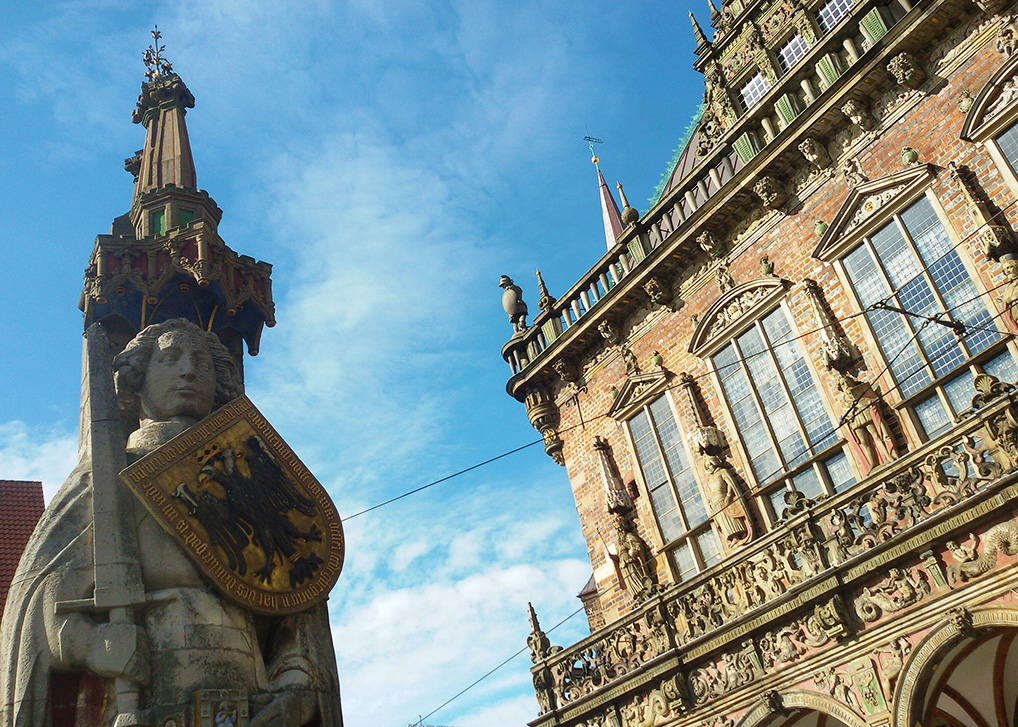
But there is far more to discover in this Free Hanseatic City.
Free Hanseatic City? Yes, that’s what Bremen has been since the city joined the Hanse association in 1358. The Hanse was a coalition of up to 200 cities with the main purpose of protecting trade routes for instance against pirating. I wrote about this powerful league in my post on Lübeck, the so-called Queen of the Hanse.
Bremen BIG
Bremen used to be an important trading center mainly due to its privileged geographic location – being only about 60 kilometers from the north sea, conveniently connected by the river Weser.
Back in those days, every European city with access to the oceans had the chance to fill the public purse. And Bremen did not only move goods, they also manufactured fine produce: Until now, the Beck’s brewery, founded in 1873, is selling beer around the globe.
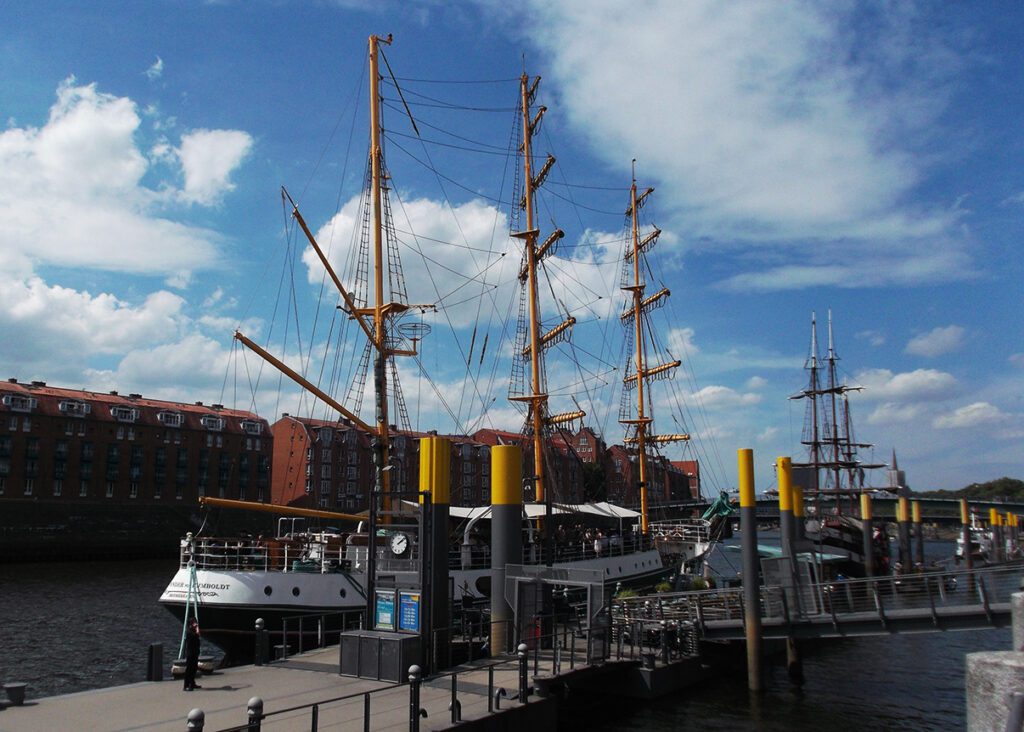
Bremen is also famous for another drink. After all, some of Germany’s largest coffee producers – namely Jacobs and Café HAG – are from here. Also, the owner of Café HAG, Ludwig Roselius, is even credited with the development of commercial decaffeination of coffee.
Just like other north European harbors, Bremen drew profit from the emigration to the New World: Between 1830 and 1974, about 7 million people migrated via the newly built harbor Bremerhaven, Bremen’s enclave on the shores of the north sea, which, of course, flushed big amounts of money in the city’s cash.
All in all, a great track record.
Bremen small
To this date, Bremen is in a particular position.
As generally known, Germany is divided into 16 Federal States. Bremen is not only a city, but also a Federal State of its own just like Berlin and Hamburg.
To be precise, together with its exclave Bremerhaven, located about 60 kilometers further north where the river Weser empties into the northern sea.
But why is it, that a city that small – Bremen has about 550,000 inhabitants – is a Federal State just like e. g. Bavaria? Besides the historical aspects, like having been a Free Hanseatic city, the reason lies in the post-war division of Germany.
Back then, the entire northwest of Germany used to be the British sector. This, of course, included the entire West German coastline. Since the Americans wanted a harbor, too, they got Bremen and its harbor Bremerhaven, geographically being part of the Federal State of Lower Saxony.
Economic Consequences
Sounds great, however, makes things difficult: You know this phenomenon that people build a cute little house in the countryside and commute to the city to work, right? Well, that’s pretty bad for the city since all their social and economic life takes place outside the city, i. e. they don’t spend the money where they make it – and this includes paying taxes. So this is one problem Bremen has to face. One problem that consequently makes the city the poorest Federal Country of all of Germany.

But how about the beer and the coffee production, you want to know? Well, in 2002, the Belgian Interbrew group bought Beck’s brewery so today, it’s part of Anheuser-Busch Inbev.
Also, Jacobs coffee is now part of Jacobs Douwe Egberts which belongs to Mondelez International.
I think they call this globalization.
The Big Tour
So yes, Bremen has it a bit difficult, but it still has kept its cultural wealth and beautiful remains from the glorious times – and most of all its charming fairy town appearance.
Just let me take you on a big tour around a small town.
Getting There
Bremen actually has an international airport that’s located about 4 km / 3 miles from the city center and therefore easily and quickly accessible: Within 15 minutes, tram #6 takes you from the airport to the main station for only 2,75 €uro.
Here you have access to all the local, regional, and national trains. In addition, it’s just a short walk to the historic center.
And Around
Bremen has a good system of public transportation. However, since there are countless ticket options, I refrain from giving advice.
A good option for visitors is certainly the ErlebnisCARD. It grants you free transportation and discounts. There are different options starting at 10,50 €uros for one adult and a child up to a group of five adults for 25,50 €uros.
Although this is a good deal, I suggest you check beforehand what you want to do and how far you have to go. The center of Bremen is not very big, you might be fine just walking.

Talking ’bout walking: Going southwest the Herdentorsteinweg, you’ll cross the Stadtgraben, the city moat, at Herdentor.
Note In this article, I’m, obviously, writing out some of the German names and places and you will notice that there are letters that might not exist in other languages:
Firstly, there is the letter ß that exists only in the German alphabet and is by no means a B – it’s a ‘sharp’, double S as in kiss. When writing, you can actually replace it by a double S.
Then there are three more vowels, ä being the easiest one since it’s pronounced like an open e as in head.
Ö and ü are tougher, ö being pronounced more or less like the e in her and ü as the u in huge.
A Rampart And a Mill
What you probably won’t see right away is that the rampart along the moat is actually in saw-toothed shape. This makes you just wait for the princess to come around the corner.
It was built in the 17th century to protect the city. However, the only occasion was during the Bremen-Swedish war in 1666. Bremen against Sweden – a new version of David against Goliath.
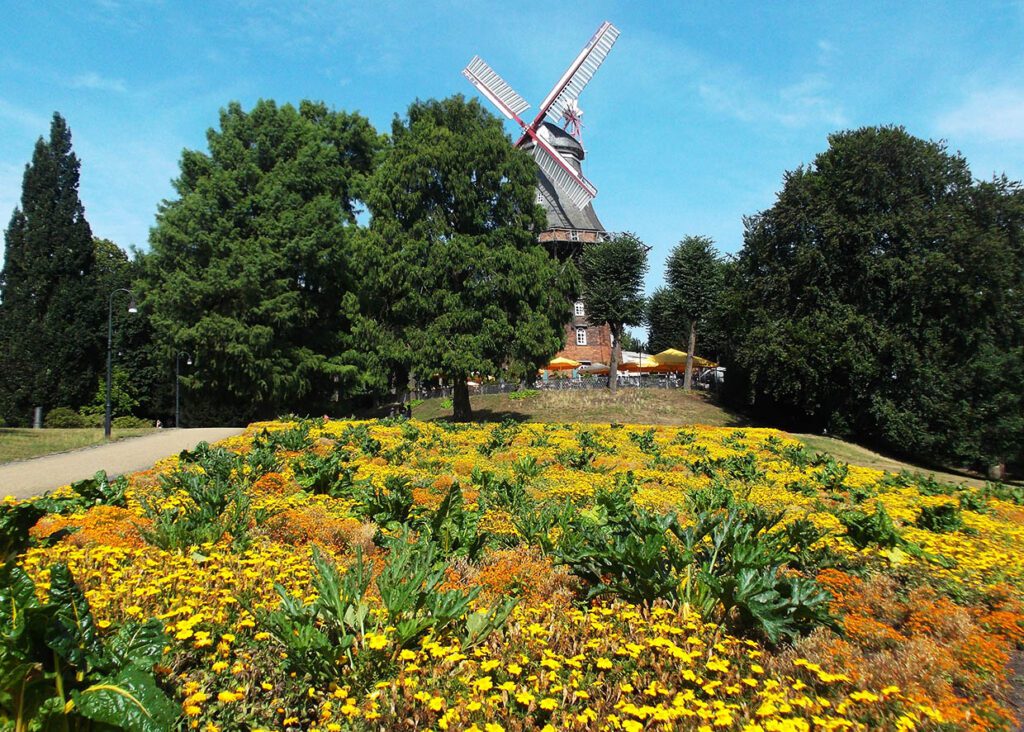
Today, the rampart is a huge, very pleasant greenery. The mill – a former grain mill, in its very first version built in 1815 – houses a lovely café, cleverly called ‘Kaffee Mühle’, coffee mill.
Kaffee Mühle
Am Wall 212
28195 Bremen
Phone: + 49 – 421-144 66
Email: info@muehle-bremen.de
The Kaffee Mühle is open daily from 9.30 a. m. till late in the evening, only from October to March it opens on weekdays only at noon.
But before you walk towards the mill, please notice a sculpture at the corner: A man with a flat cap standing in front of some city models.
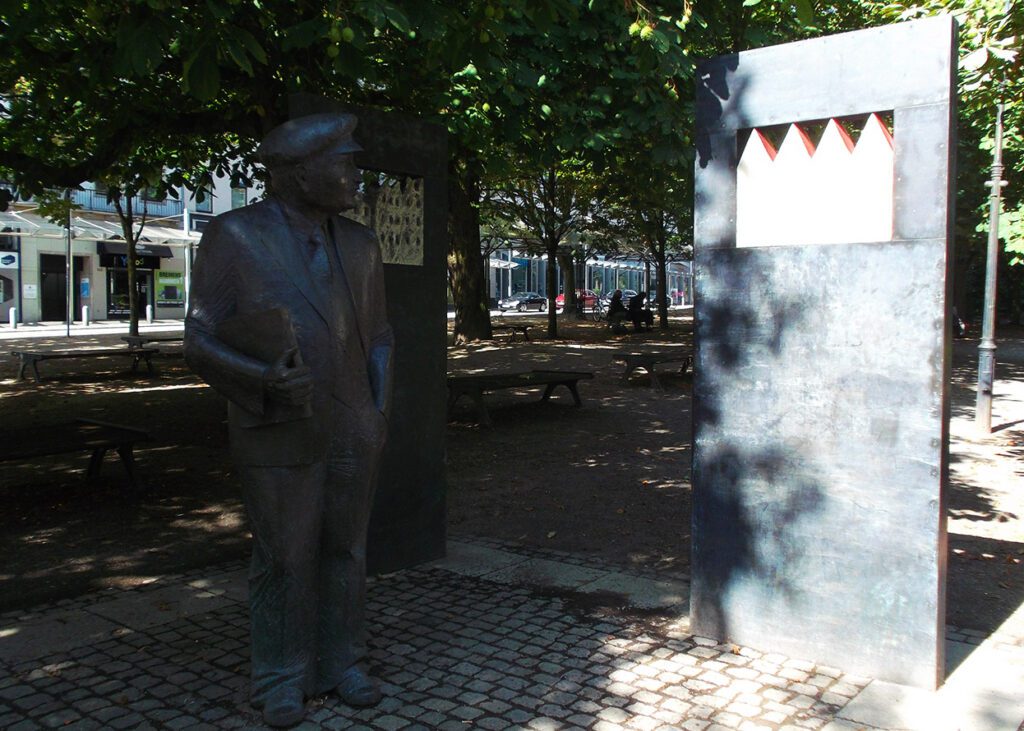
This is Mr. Wilhelm Kaisen, who after the war was for twenty years the 2nd President of the Senate and Mayor of Bremen and mainly in charge of the city’s reconstruction and redevelopment.

The Center
Walking along the rampart takes you to the next bridge crossing the city moat. Here you turn left into the Ansgaritorstraße that ends at the Ansgarikirchhof and to your right, you’ll spot the Gewerbehaus, the trade building, built in the 17th century and site of Germany’s oldest chamber of crafts founded in 1849.

Turn right into Hutfilterstraße and you’ll get to the savings bank Sparkasse Bremen. In front of the bank is the Affentor, the apes gate, a large sculpture by Germany’s enfant terrible Jörg Immendorff.
Enjoying Life Around the Schlachte
From here, it’s only two blocks to the Schlachte, the promenade along the river Weser. Especially in Summer when all the bars and restaurants have their terraces open, there is an almost Mediterranean flair to this otherwise totally northern city.
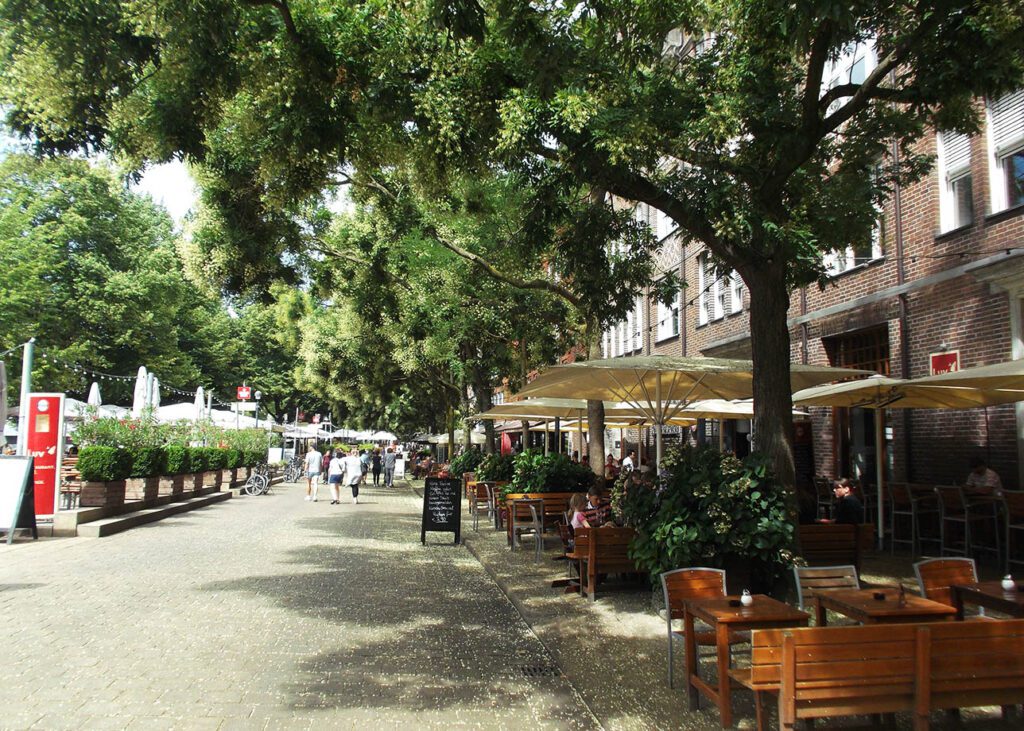
Along the Schlachte you can enjoy all sorts of local and international cuisines.
Once you’re done eating and drinking and observing and relaxing, let’s walk along the Weser up north and turn right into Große Fischerstraße.
At the next corner, you have the great opportunity to get a taste of what made Bremen great: Coffee.
The roastery Münchhausen does not only sell excellent coffee, they also offer tours. Since it’s a really small company, you absolutely have to check with them beforehand. Also, their shop is open only from Monday to Friday from 10 a. m. to 12.30 p. m.
Kaffeerösterei Münchhausen e.K.
Geeren 24
28195 Bremen
Phone: + 49 – 421 – 12 100
Email: info@muenchhausen-kaffee.de
As you keep on walking down the street Geeren, you’ll get to Radio Bremen, the local broadcasting station. Across the street, you’ll spot a beautiful building, the Architektenhaus, a Renaissance building from 1625, housing the Chamber of Architects. Sometimes, life is so logical…
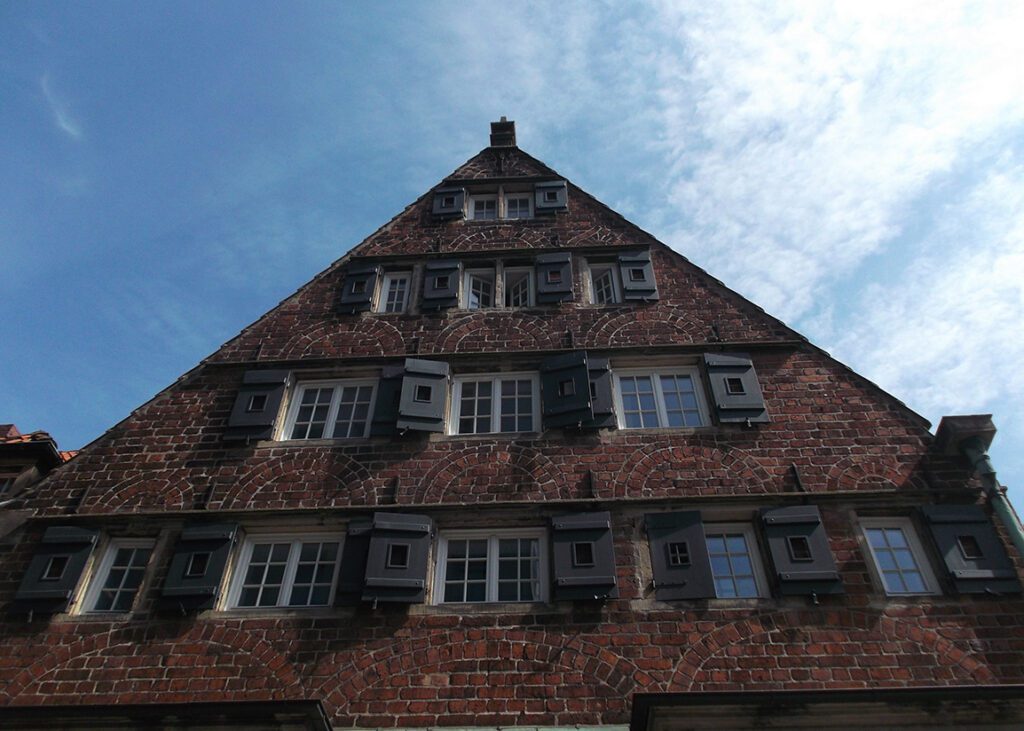
The Arts in Churches
Further on up the road, you’ll get to the Kulturkirche St. Stephani. Now, this is a really special church. Built in the early 12th century, over the centuries, it had to be altered and remodeled. Actually, this is quite normal for this kind of building. However, in WWII, it was totally destroyed and rebuilt in the 1940s and 50s.
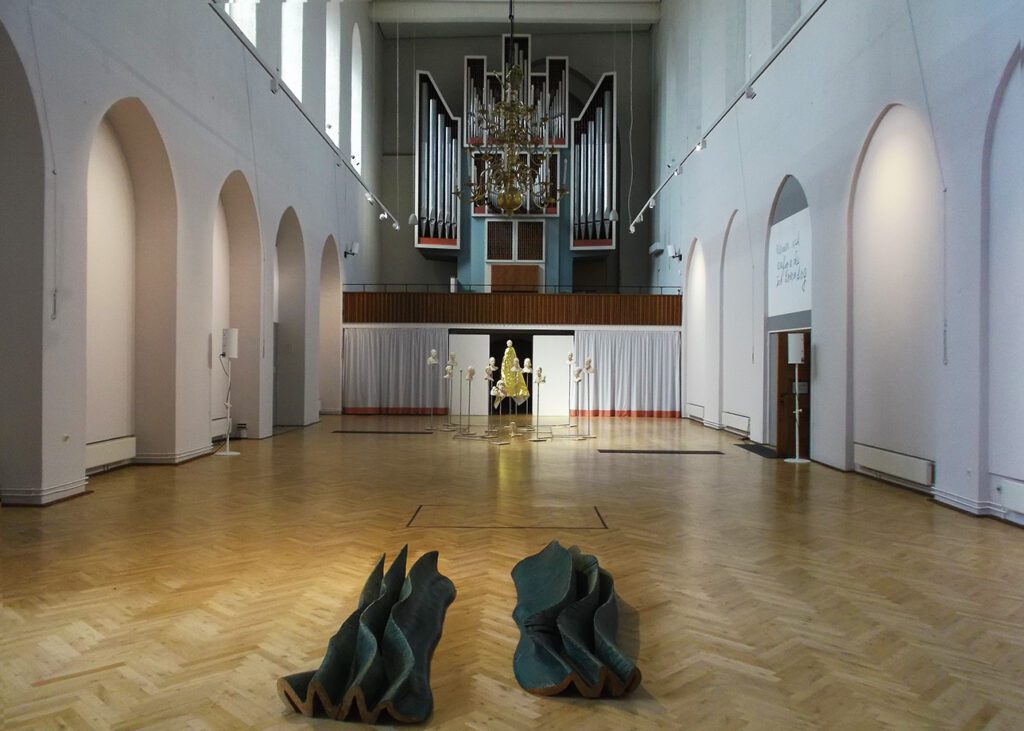
On January 1, 2007, the church became a Kulturkirche, a cultural church. Now it’s a venue where they perform music, visual arts, theater, dance, films, and lectures; and from time to time services.
Kulturkirche St. Stephani
Stephanikirchhof
28195 Bremen
Phone: + 49 – 421 – 303 22 94
Email: info@kulturkirche-bremen.de
As you cross the Stephanibrücke, the Stephani bridge, to the other side of the river Weser, we’ll get a bit more secular: Here you can get in touch with one of Bremen’s strongest suits, the Beck’s beer. Although it now belongs to Anheuser-Busch, they still stick to the old brewing traditions and you can take a tour.
You can book the tour online with the people from Bremen Tourismus. While this tour is available in English, too, their coffee tour is only in German.
And Other Old Structures
As you walk back towards the center along the river Weser on the street Am Deich, to your right, you’ll spot another coffee roaster, AZUL, also known for fine artisan coffees.
At the next bridge, let’s cross to the peninsula in the river. Here, on the Teerhof where in the old times they used to melt tar for the ships, in 1893, the cigarette factory Ad. Hagens & Co. was opened.
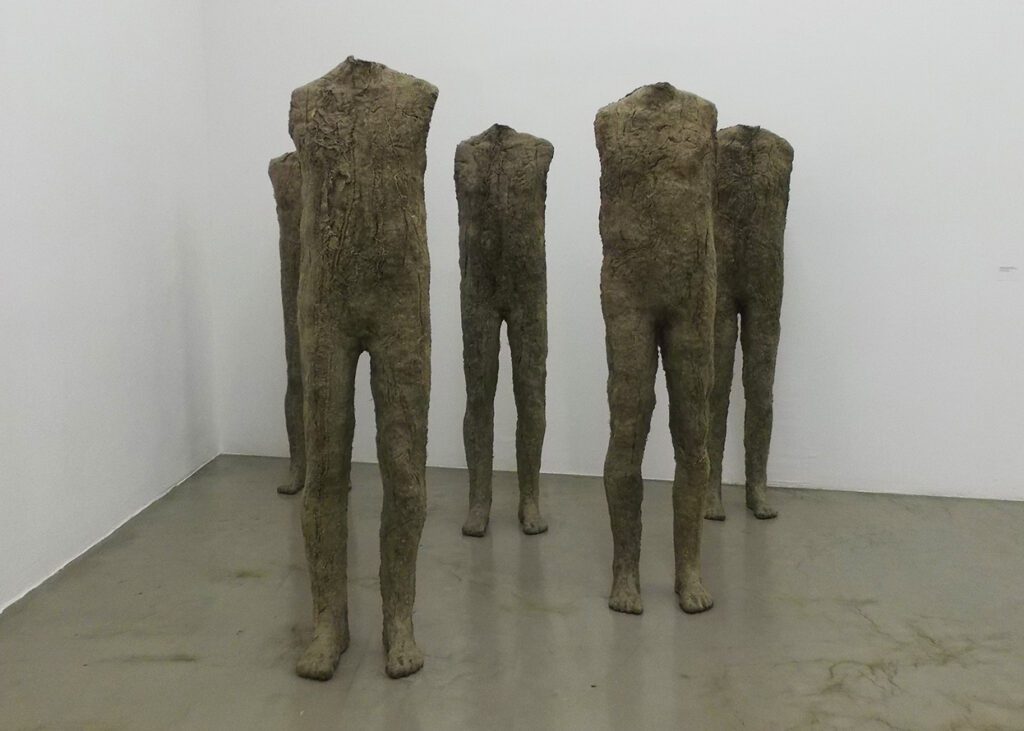
one piece of the very impressive exhibition of works from the Signum Foundation, founded by Hanna und Jaroslaw Przyborowski.
I admired another fantastic work of this great artist at the City Museum of Contemporary Art in Hiroshima.
Today, the building is known as the Weserburg. It is housing a modern art museum with changing exhibitions and no permanent collection.
Weserburg | Museum für moderne Kunst
Teerhof 20
28199 Bremen
Phone: + 49 – 421 – 59 83 9-0
Email: sekretariat@weserburg.de
Open Tuesday to Sunday from 11 a. m. to 6 p. m. (Thursday to 8 p. m.)
Bremen’s Parlor
Cross the Weser back to the ‘mainland’ and walk up one block to Martinistraße and keep walking towards the center into Langenstraße.
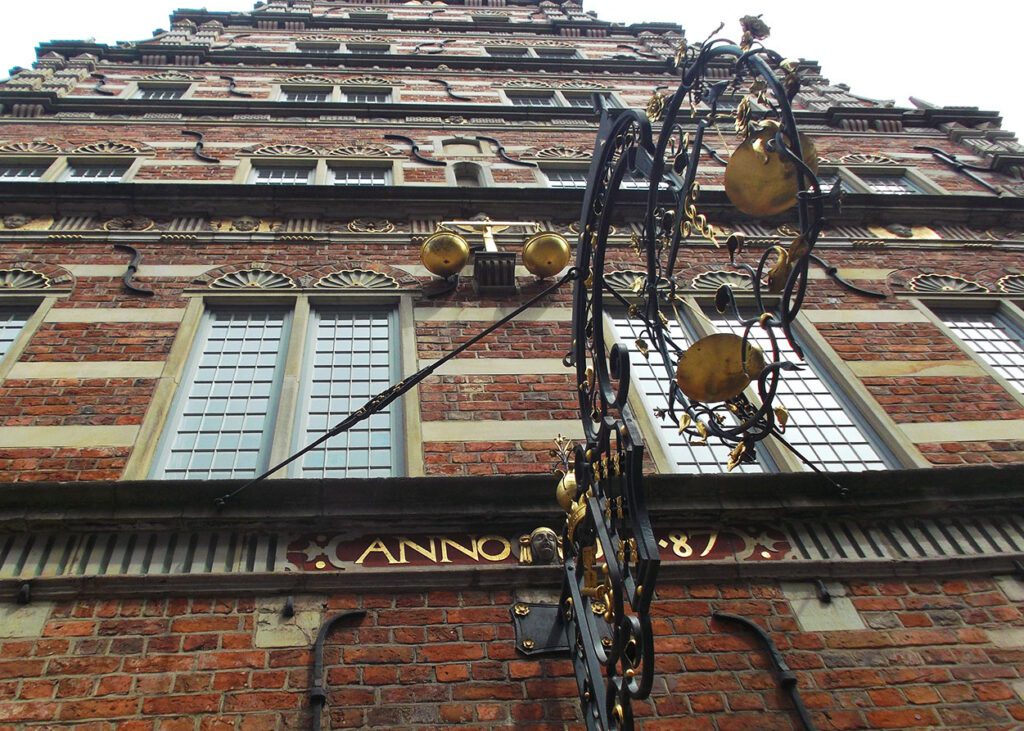
To your left, you’ll spot a beautiful building and if you look up, you’ll see the Stadtwaage, the old weighing scale. Mentioned firstly in 1330, it is now on a newer building from the late 16th century. This scale used to be the official balance so none of the honorary merchants could cheat.
From here it’s only two blocks to the main square, the locals refer to it as Gute Stube, the parlor. Since 2004, the old town hall along with the Roland statue has been part of the Unesco World Heritage.
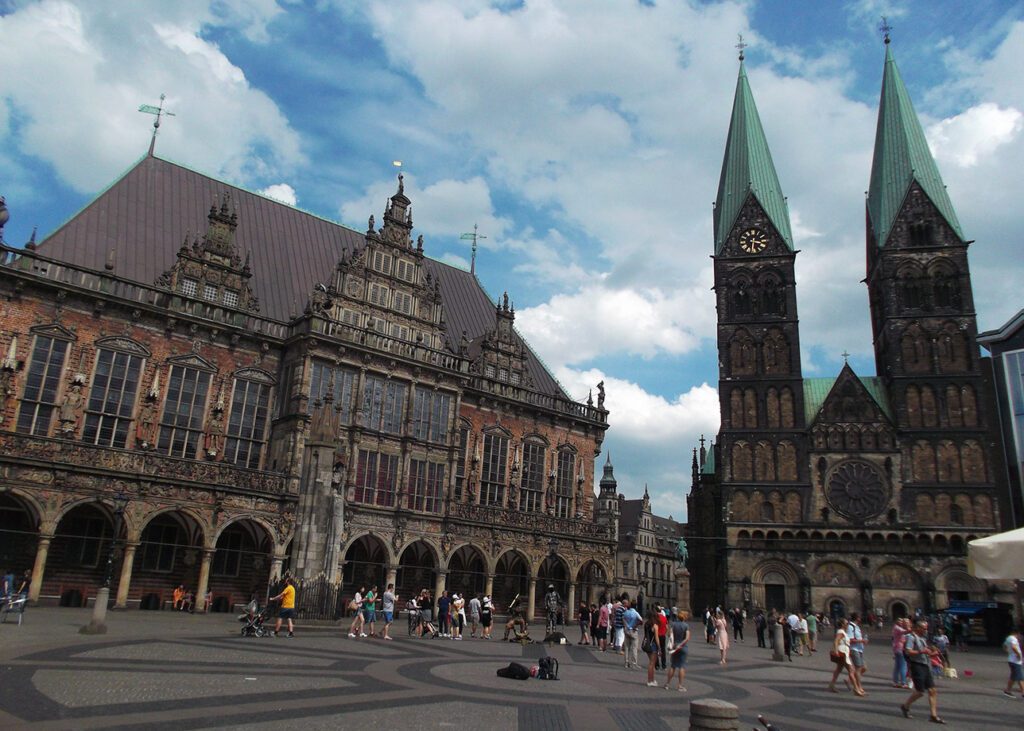
The town hall stems from the early 15th century, the Renaissance facade was added in the 17th century. It is the only European town hall from medieval times that has never been altered or destroyed.
Rathaus Bremen
Am Markt 21
28195 Bremen
The town hall can be visited on different guided tours. You have to book your ticket with the Bremen Tourismus.
Bremen Remains Free
Mr. Roland was born….er…built in 1404. He stands 5 meters / 16.5 feet tall. With the column in his back and the canopy, he reaches 10 meters which makes him the tallest freestanding medieval statue.
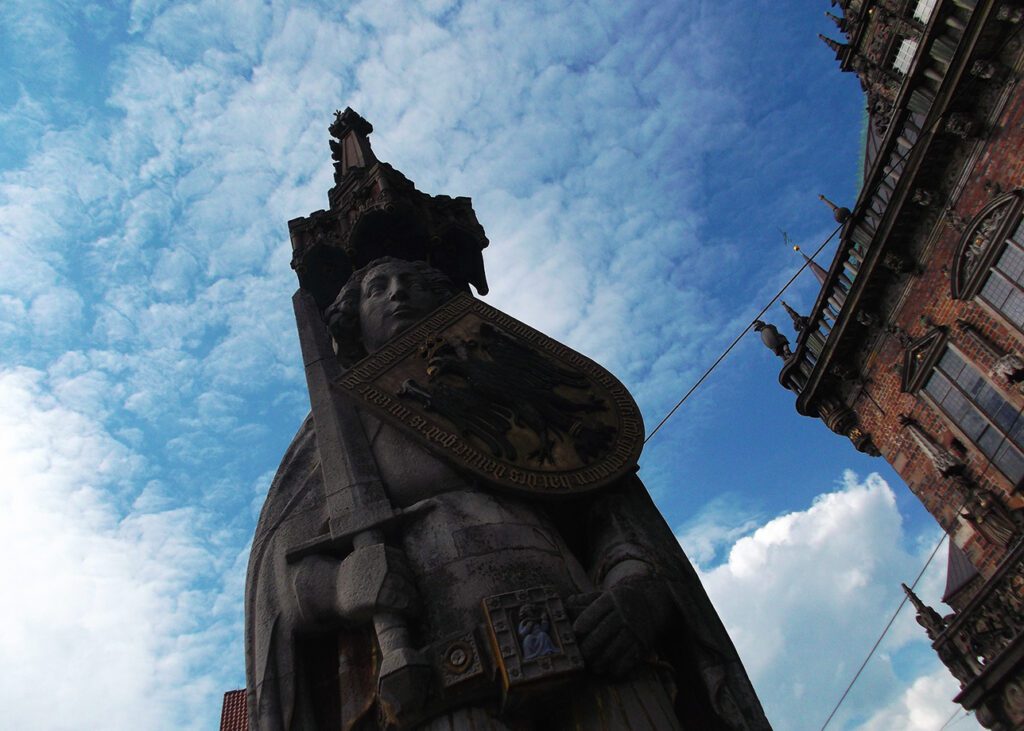
Roland was Charlemagne’s nephew. It is believed that Bremen remains free and independent as long as the Roland is standing strong.
Although he has a good head on his shoulders, it’s just a copy. You can see the original at the Focke Museum.
The Focke museum is all about Bremen and its history. It is located about 45 minutes outside of the center, but can be easily reached by various trams such as #1, #4, or #6.
Focke-Museum
Schwachhauser Heerstraße 240
28213 Bremen
Phone: + 49 – 421 – 699 600 – 0
Email: post@focke-museum.de
Open Tuesday to Sunday 10 a. m. to 5 p. m. (Tuesday to 9 p. m., Sunday to 6 p. m.)
By the way, a Roland statue depicts a knight with a sword and is considered a symbol of city rights. Roland statues are therefore mostly in marketplaces or in front of town halls – like for instance in Dubrovnik and Riga.
Houses of Worship
Two churches flank the town hall: Unser Lieben Frauen Kirche, Church of Our Lady. Today an Evangelical Protestant church, it dates from the 13th century.

On the other side of the town hall is the St. Petri Dom, Saint Peter’s cathedral. Of course, you can visit the cathedral, but don’t miss out on their Bibelgarten, the serene bible garden where you actually do find a bible – and more than 60 different plants, most of them mentioned in the bible. There is also a statue of Saint James since the Camino de Santiago leads through Bremen.
Make sure to visit the so-called Bleikeller, the lead cellar: Here a couple of mummies remind you that life is finite.
To have a grand view of Bremen, you can climb one of the church towers.
The hours of all these visits and activities vary by season and weekday, so please check their website.
St. Petri
Sandstraße 10-12
28195 Bremen
Phone: + 49 – 421 – 36 50 40
The Town Musicians
Between the town hall and the church is the most iconic attraction Bremen has to offer, evidently, the sculpture of the Bremen town musicians. According to a fairy tale by the Brothers Grimm, a donkey, a dog, a cat, and a rooster run away from their ungrateful master to make a living as town musicians in Bremen.

…hence, they never made it there
As a matter of fact, there is only the statue of these four since according to the tale, they never made it to the city.
However, today they are a huge marketing plot.
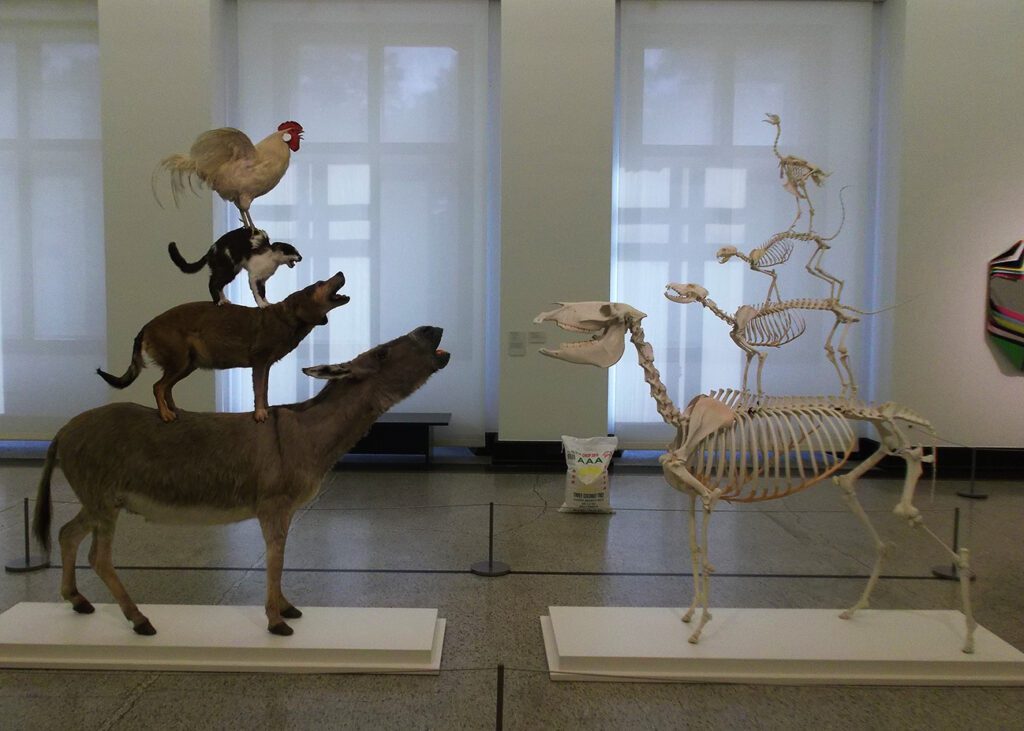
They can be visited at the Kunsthalle, the art museum. You’ll find further info and details below.

Rubbing the donkey’s hoves is supposed to bring luck. But you have to rub both, otherwise, it’s just one ass shaking another one’s hand.
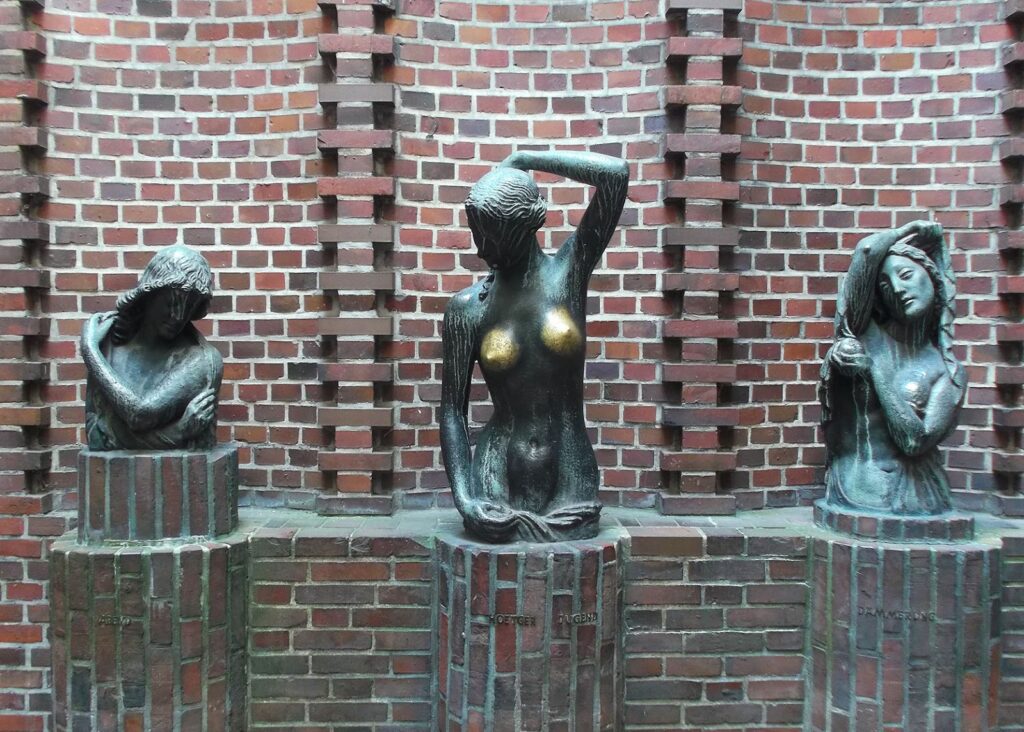
These are by Bernhard Hoetger and called Abend, Jugend, Erinnerung, Evening, Youth, Remembrance – to be found at Böttcherstraße.
Böttcherstraße
Across from the town hall, next to the Haus Schütting, a beautiful structure built in 1537/1538 in a late gothic style is the entrance to one of Bremen’s cutest alleys, the Böttcherstraße.
It’s packed with intriguing little specialty shops like artisan coffee roasteries, shops, café, and original restaurants.
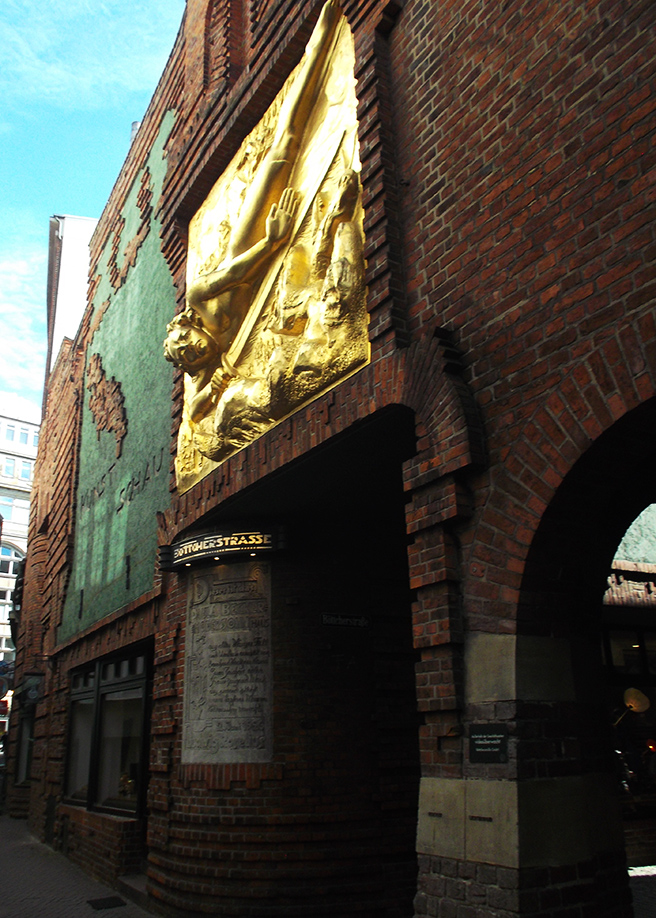
Hoetger designed him in 1936 trying to appease the Nazis and gaining their acceptance.
“I thought I could finally prove to the world how much I admire our Führer and
his deeds”, Hoetger wrote to a Swiss friend.
But in 1943, he had to flee the Führer’s good deeds to Switzerland.
Besides the Glockenspiel on number 4 -6, the former home of Mr. Ludwig Roselius is one of the most impressive sites.
Remember?
It’s the fellow who commercialized decaf and, of course, got wealthy.
Today, it houses the paintings of Paula Modersohn-Becker and his collection of furniture and nick-nacks.
Also, changing exhibitions are taking place.



The Museums at Böttcherstraße are:
Museen Böttcherstraße
Paula Modersohn-Becker
Museum Ludwig Roselius Museum
Sammlung Bernhard Hoetger
Böttcherstraße 6–10
28195 Bremen
Phone: + 49 – 421 – 33882-22
Email: info@museen-boettcherstrasse.de
Expressionism in Bremen
Behind his house is the Handwerkerhof, the craftsmen’s court. Here you can also admire the Sieben Faulen Brunnen, the well of the seven idles. This well is beautifully illustrating a tale by Friedrich Wagenfeld on a poor farmer’s seven lazy sons. These idles pretended to support their father with their crazy albeit innovative ideas; kind of a fairytale 2.0. However, this is a very special, strictly local story.

It stands in front of one branch of the Bremer Bonbon Manufaktur, a sweet shop where you can witness how your candy is being made.
The buildings and the sculptures were designed by Bernhard Hoetger, an expressionist artist.
To be honest, Mr. Roselius was not exactly an enemy of the Nazis, but because of his hang for expressionist art, e. g. Paula Modersohn-Becker’s paintings, they were not so fond of him.
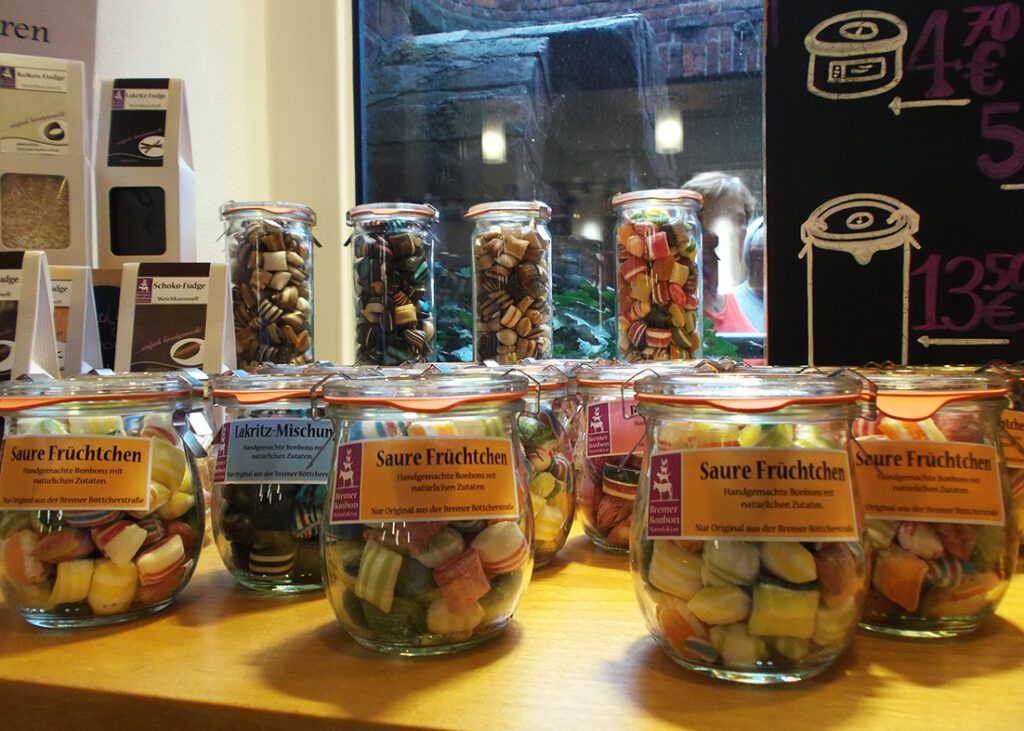
The same goes for Bernhard Hoetger: He did even join the Nazi Party but was eventually expelled for his ‘degenerated’ art. To me, because of this, he does not qualify as a resistance fighter, although he had to migrate to Switzerland.
However, luckily the Nazis decided to keep the Böttcherstraße as a daunting example of ‘degenerated’ art and did not destroy it so that today we still can enjoy its beauty.
The Schnoor
Do you think that the Böttcherstraße is the cutest old neighborhood? You’ll stand corrected as soon as you get to the Schnoor, the neighborhood a couple of blocks east. You get there strolling east on the quay along the river Weser.

The Schnoor is a neighborhood and therefore, most streets and alleys here are named according to old handicrafts associated with shipping. Since the Schnoor was a rather proletarian, poor neighborhood, it remained basically undestroyed during the wars and therefore kept its medieval character.
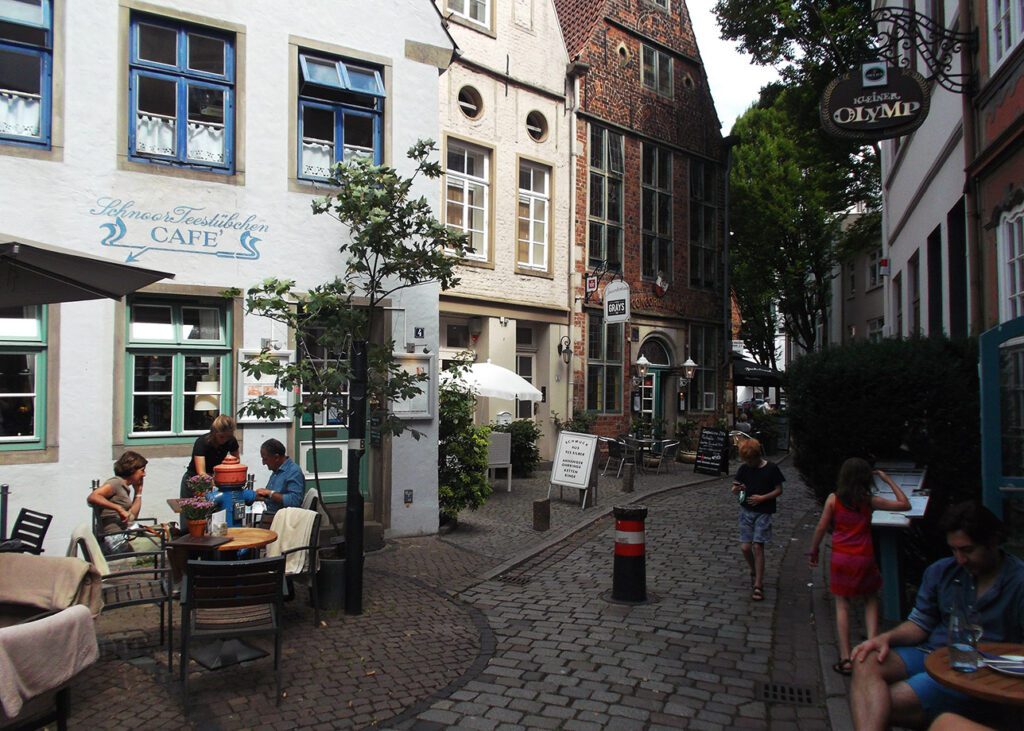
Today, of course, it’s a rather hip area with lots of small specialty shops, restaurants, bars, and the Hochzeitshaus, probably the world’s smallest hotel with only one room that accommodates two people.


Some Things Modern
Adjacent to the Schnoor, in the southern part of the rampart, is the Kunsthalle Bremen, Bremen’s art museum.

They have a good collection from basically all epochs and organize temporary exhibitions of contemporary art like the Town Musicians by Maurizio Cattelan published above.
They also have an interesting and beautiful light work by shooting start James Turrell.
Kunsthalle Bremen
Am Wall 207
28195 Bremen
Phone: + 49 – 421 – 329 08-0
Email: info@kunsthalle-bremen.de
Open Tuesday to Sunday from 10 a. m. to 5 p. m. (Tuesday to 9 p. m.)

Bremen’s Bauhaus-Artists
However, right next door is Gerhard-Marcks-Haus which you should visit: Gerhard Marcks created the town musician sculpture in 1951 – and many more great works. Also, Marcks was a member of the Bauhaus art movement.
Gerhard-Marcks-Haus
Am Wall 208
28195 Bremen
Phone: + 49 – 421 – 98 97 52 0
Email: info@marcks.de
Open Tuesday to Sunday from 10 a. m. to 6 p. m. (Thursday to 9 p. m.)
Across the street is another great exhibition on Bauhaus design. The Wilhelm Wagenfeld Foundation, obviously, shows the fantastically innovative works of industrial designer Wilhelm Wagenfeld, born in 1900 in Bremen. The foundation is accommodated at the former gatehouse, built in 1826- 1828 in a classicist style.
Wilhelm Wagenfeld Stiftung
Am Wall 209
28195 Bremen
Phone: + 49 – 421 – 33 999 33
Email: info@wilhelm-wagenfeld-stiftung.de
However, the foundation is only accessible on the occasion of special exhibitions, there is no permanent collection on display: Tuesday from 3 p. m. to 9 p. m. and Wednesday to Sunday from 10 a. m. to 6 p. m.
Looking Back at History
From here you can comfortably stroll back along the rampart back to the train station.
But wait a moment, right next to the station is another museum you might not want to miss, the Übersee Museum. Due to Bremen’s location close to the northern sea, the city was not only a gateway to the world, they also brought lots of wonderful art back with them. It’s a bit like a smaller version of the British Museum, but definitely worth a visit.
Übersee-Museum Bremen
Bahnhofsplatz 13
28195 Bremen
Phone: + 49 – 421 – 160 38-0
Email: office@uebersee-museum.de
Open Tuesday to Sunday from 9 a. m. to 5 p. m. (weekends from 10 a. m.)
Map
On this map, you’ll find all the wonderful places I’m introducing in this post.
Clicking on the slider symbol at the top left or the full-screen icon at the top right will display the whole map including the legend.
So this is Bremen – I hope you like it.
As you know, the Federal State of Bremen consists of two cities: Read in this complete guide what great attractions Bremerhaven has to offer.
Pinnable Pictures
If you choose to pin this post for later, please make sure to use one of these pictures:

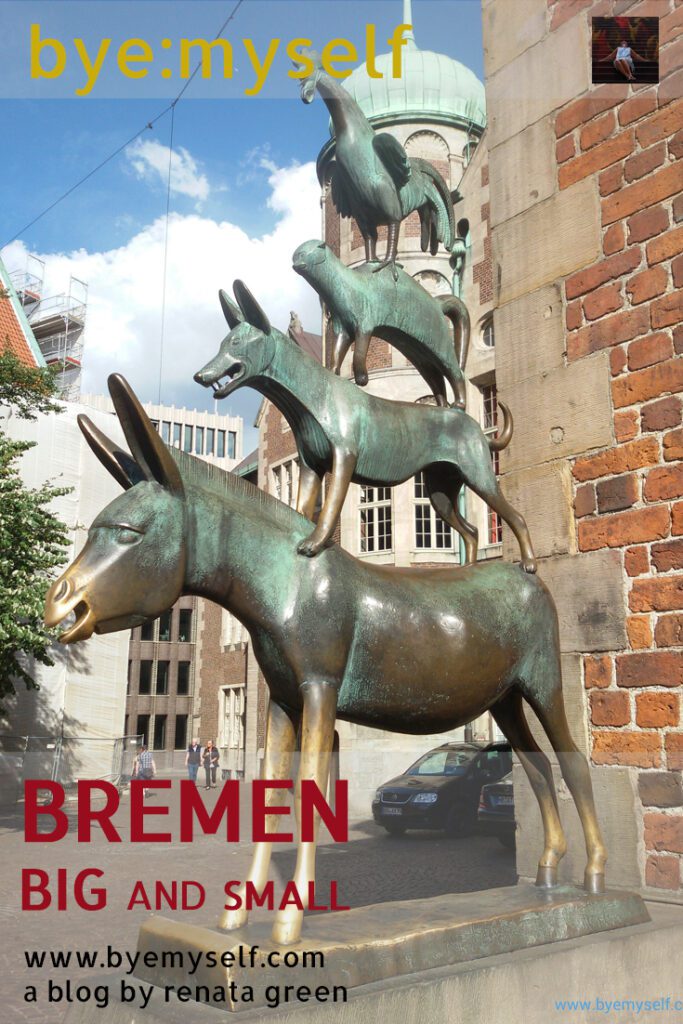
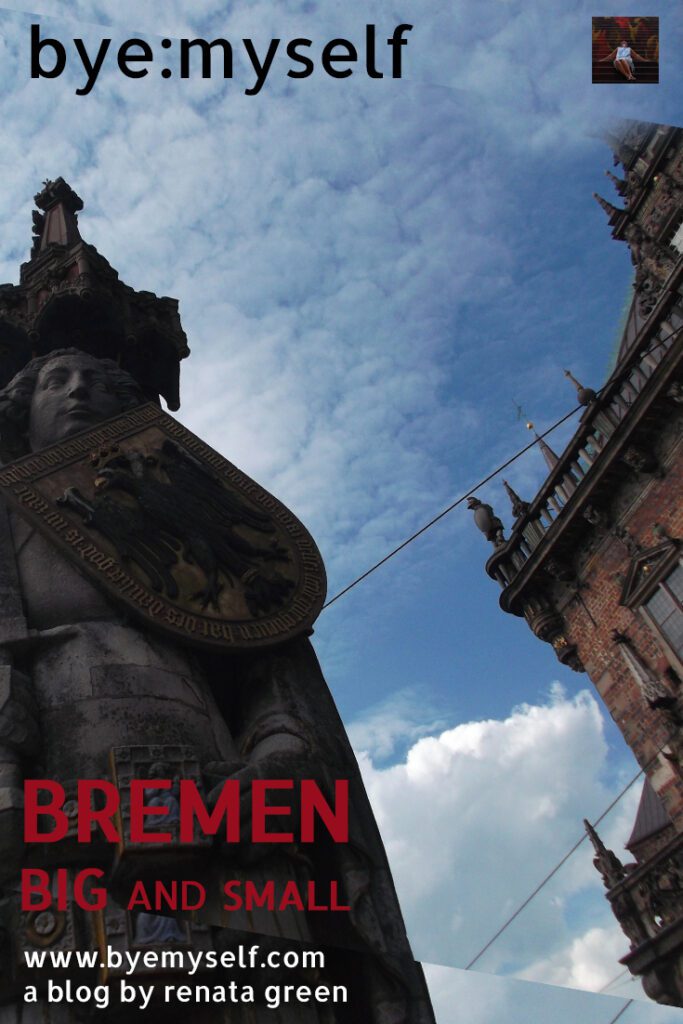
Note: I’m completing, editing, and updating this post regularly – last in January 2023.
Did You Enjoy This Post? Then You Might Like Also These:

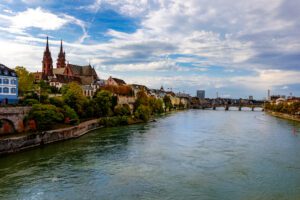
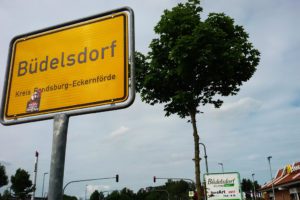



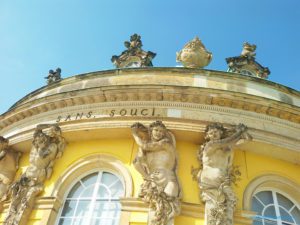

I love to visit a spot like Breman that is not a more popular tourist spot. Although surprising given that it includes a UNESCO site. We would certainly be fine just walking around the city centre. I love all the fun statues. I am sure I know which ones are rubbed most! The inside of Kulturkirche St. Stephani is certainly quite unique. It reminded me of some of the churches we found in the Norway fjord towns. A lot to do on a visit for sure.
Bremen is a city I have been wanting to visit for quite some time now, I even had it on my bucketlist for a few year, but I never got around to it…
Some of the architecture in the buildings is great. I can definitely see the German influence in some of my favourite cities in Poland. And they do seem to love their 'interesting' sculptures here too! It's great to read about somewhere outside the usual big cities as well, I much prefer visiting these places too.
Awesome to get outside the more well-known centres and find out about places like Bremen. I'd never heard of it before! Very informative post. I'd like to visit that Weserburg with the musuem of modern art. Looks like a very cultural city!
I never knew anything about that Hanse Association! I wonder what other cities are a part of it. I love exploring lesser-traveled cities like this! It looks like Breman offers a lot for a fun and relaxing weekend away!
I had never heard of Bremen, but it certainly looks like an interesting place to visit! Love how the town looks so different in different areas!
Bremen looks wonderful! I especially love the little cobbled streets and the Windmill in the park. Love architecture like that!
Ami xxx
Haven't been to Bremen yet, but there seems to be a lot to do. I love the architecture in all such European cities, which has a mix of both old towns and new town. Its really amazing how two different characteristics of the city exist under one umbrella, and both thriving at the same time.
Will be in Munich and Oberstaufen in October. We will not be able to go to Bremen. Too bad. Love your comprehensive post of a fairyland. Lots of history and culture!
I have not heard of this area so it was so fun to learn about a new location. I love all the architecture and the narrow streets with brick pavement is so cute. The city also looks super clean.
What an interesting read. I haven't heard of a church being use for cultural activities, but I think that it is an excellent idea. The art is interesting and these seems to be quite a bit around the city. Doing an art walk would be fascinating.
I have been to Europe thrice but never to Germany. I only know Bremen through their good football club. Your post has entirely changed my perception of this place. Especially loved the intricate architecture on the town hall. Will try and make it next time. This is a handy post with great tip. Thanks
Bremen looks wonderful. Great guide and very helpful map. The culture and architecture looks amazing. Can’t wait to see it in person someday!
I think Bremin would be a favorite of many tourists who have passion on designs and arts. Lots of interesting architectures and designs around this city.
interesting and lovely city. You made a very comprehensive review whether with the pict or the informations here, great!
Bremen sounds lovely! I'm huge into fairytale towns so clearly I need to add this to my bucket list. I've really never heard much about Bremen but I am certainly interested in visiting now! Whenever I decide to go I'll be sure to use your detailed guide to ensure I have the best trip there.
This is definitely a complete city guide. Love the sound of Bremen. Would like to visit it one day.
Wow! Bremen looks really nice. My family would love a tour here. I like simple places and explore the locality, the food, the culture, and meet the locals.
Hearing about Bremen for the first time as it is not spoken much of when talking about Germany. The place seems to have a long and rich historical significance and its sad how as you mentioned, globalisation can have challenging economic impacts. From the pictures and the post, Bremen looks like a city we would love to explore for the cultural and vibrant look it has preserved. Hope tourism gives some economic boost too here!
This isn't a part of Germany I've come across or even heard of. But the photos make it look stunning and it's nice to head to places which are less touristy x
Bremen is indeed a lovely nordic city in Germany, loved the picture with the interpretation of Bremen's musicians! Looks pretty cool! Next time you might visit Hamburg, my cool ex-hometown!
Kate, https://elysianmoment.com
Hahaha, I'm based in Hamburg and actually did publish an extended post a couple of weeks ago: httpss://byemyselftravels.blogspot.com/2018/01/HAMBURG-GUIDE.html
Germany has such interesting architecture. And those sculptures are interesting. I would definitely hit up the art museum. Such fabulous places you found! 🙂
I am so thrilled to read this post. I visited Bremen about 5 years ago and found it incredibly charming. It was in the winter and I was on a business trip, so I didn't really explore the city as I would have liked. This is a great read to a city, rich in history and not often visited. Cheers
This city has a lot of history in it, and there are so many places to visit. You have gave an amazing review of the city, would love to visit someday. Great post.
I feel like I was right there with you!! It sounds like you had an amazing time. Amazing photos!
Haven't heard of Bremen before. Sure was surprised by that apparently dutch looking windmill photo. Love the amount of history associated with the place and the open cafes and restaurants. Insightful, and helpfully crisp information.
Wow, the old market square with the town hall is incredible. I've been to several places in Germany but not yet to Bremen; it's good to know it only costs 2.75 euros, that's cheap! I also never knew about the coffee history there, how interesting!
I've heard a lot about Germany, its beauty and historical values but Bremen name is totally new to me. This post and specially the images describe clearly what it should be like.
I haven't been to Bremen myself but it looks great. And I love historical buildings, and finding out more about the place so this looks like a great place to go!
Jackie – Organised Mum Life
Wow what an amazing trip you had! I love to visit museums when we travel, I find it fascinating to see what each country has to offer!
Bremen does look quite Dutch. I didn't realise it was a Hanseatic Port (I grew up in one in England so I am always fascinated by them!). I'd love to visit for myself
This town has such a wonderful history, I can't wait to visit it, the part that got me real excited is most definitely the donkey, dog,cat and rooster legend, and of course the homemade candies.
I haven't been to Bremen but it looks like the perfect size city to explore. I wouldn't have expected windmills either! And how crazy is the sculpture with the animals on top of each other. Looks like a fun city.
Such a detailed and interesting post on Bremen, its history, and all that lovely art. This post will be very useful to anyone wanting to visit Bremen.
I love Bremen, its a fantastic city. Love walking around the quaint streets and seeing the beautiful buildings. Love the bars as well but not to drink that local brew 'Becks' 😛
I love the three sculpture pieces by Gerhard Marcks and Maurizio Cattelan it is almost like they finally made it and are entertaining people like the Donkey in the tale had promised.
We would love to visit Bremen and see all that beautiful public art for ourselves. We love the cultural relevance and tactile nature of public sculpture and murals.
Thanks for sharing. Keep travel blogging. Adventure is better shared with friends!
I really love architecture so Bremen definitely appeals to me. I have never read anything about this city before so I was very interested in this post. I would certainly go to the Weserburg to see the modern art as well. Thanks for putting Bremen on the map for me!
Your welcome, Mellissa, I'm glad I could inspire you. And yes, the exhibitions at the Weserburg are always really good.
Never been to Bremen, but you got me with the first part of the post. The historic old town definitely sound like the place I'd love to explore. The old market square and those narrow streets – my favorite already! 🙂
Didn't know it was a separate Federal State as well, interesting. And thanks for the transportation tips, good to know.
Can't wait to get to Bremen! 🙂
I'm glad I was able to inspire you. It really is very cute. Next week, I'll post on its exclave Bremerhaven – this combined should be the perfect Northern German experience…
We love Bremen, it is a fairytales town. It is true is not small, not big. We loved to be on the weiser river with our beer watching the sunset!
That sounds like a perfect plan: Beer from Bremen in hand watching the sun go down over the Weser – and call it a day!
Happy travels, you guys!
I never knew what a rich history the city of Bremen possessed. I've heard of it, but it was never more than a blip on a radar of places worth visiting so thank you for creating such a detailed and useful city guide that has given me an entirely new perspective on Bremen. Paired with the fact that it's the home of Beck's…I'd like to have a cold one and watch the sun go down over thr Weser as well!